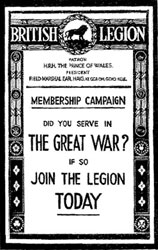2011 - 90 years of the Royal British Legion
The Royal British Legion was formed on 15 May 1921 bringing together four National Organisations of ex-Service men that had established themselves after the Great War of 1914-1918.

As a result of the war, Britain's economy plummeted and in 1921 there were 2 million unemployed. Over six million men had served in the war - 725,000 never returned. Of those who came back, 1.75 million had suffered some kind of disability and half of these were permanently disabled. In addition were their dependents - wives and children, widows and orphans.
By the time of the Legion's formation in 1921, the tradition of an annual Two Minute Silence in memory of the dead had been established. The first ever Poppy Appeal was held that year with the first Poppy Day on 11 November 1921.
Sapper William Hackett VC - a story for Remembrance Sunday 2009
 Entombed 40ft beneath the killing fields of the Western Front when the tunnel he was in caved in, Sapper William Hackett spurned the opportunity to crawl to safety in order to remain behind to comfort a wounded comrade, before a second collapse sealed the two men in forever.
Entombed 40ft beneath the killing fields of the Western Front when the tunnel he was in caved in, Sapper William Hackett spurned the opportunity to crawl to safety in order to remain behind to comfort a wounded comrade, before a second collapse sealed the two men in forever.
This extraordinary act of courage was chronicled in fellow Sapper John French's diary which has recently come to light. Read full story.....
Beneath Flanders Fields
“The area around Ypres saw some of the war's heaviest fighting, as well as some of the most extensive tunnelling.
Around 500,000 soldiers and civilians died in the nine square miles around the market town, and almost every tree and building was flattened.
In the Flanders landscape devoid of natural cover, tunnelling was the only way to provide a life protected from incessant shelling, which could penetrate up to 30ft below ground.”
 A glimpse of the lives of soldiers 50ft beneath the battlefields of the Western Front. The first "tunnel town" from the First World War to be excavated reveals mining skills and a love of HP sauce.
A glimpse of the lives of soldiers 50ft beneath the battlefields of the Western Front. The first "tunnel town" from the First World War to be excavated reveals mining skills and a love of HP sauce.
Read full article from Sunday Telegraph 9 November 2008
Accounts of life in the "tunnel towns" that sprawled beneath the Western Front can be found in Beneath Flanders Fields, by co-secretaries of the All-Party Parliamentary Group, Peter Barton and Peter Doyle, together with Johan Vandewalle.
 After unearthing the entrance to the original shaft, the team, led by academics from the University of Glasgow, followed it down 50ft below ground, after pumping out hundreds of tonnes of mud and water. This photograph is of Dr Tony Pollard from the Centre for Battlefield Archaeology at Glasgow University, who also led the team which carried out excavations at Pheasant Wood, Fromelles, in 2008.
After unearthing the entrance to the original shaft, the team, led by academics from the University of Glasgow, followed it down 50ft below ground, after pumping out hundreds of tonnes of mud and water. This photograph is of Dr Tony Pollard from the Centre for Battlefield Archaeology at Glasgow University, who also led the team which carried out excavations at Pheasant Wood, Fromelles, in 2008.